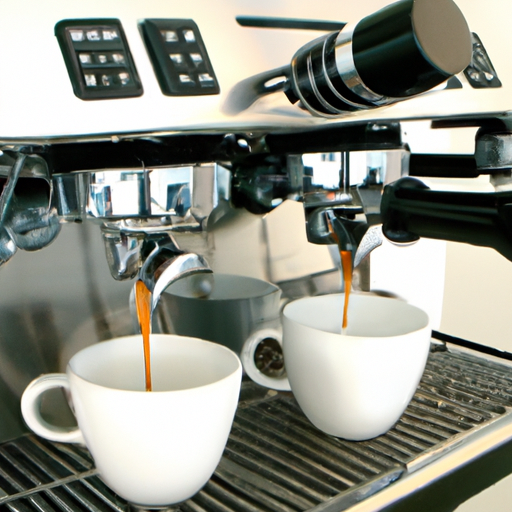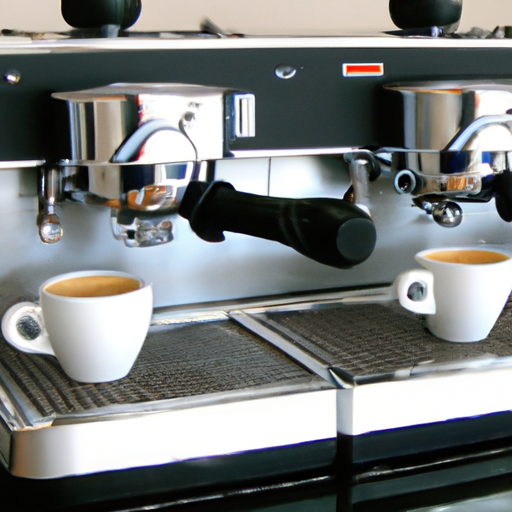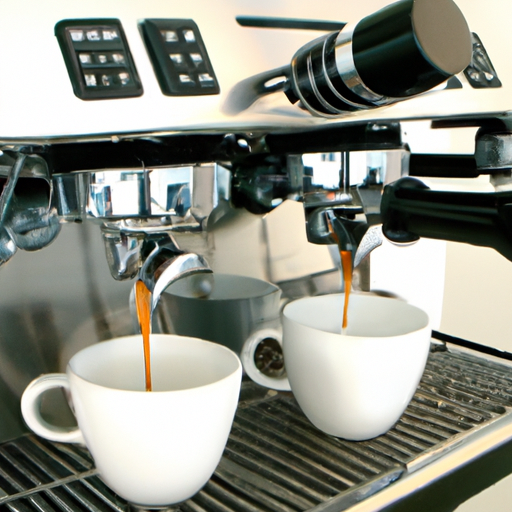Have you ever wondered what makes a super automatic espresso machine different from a semi-automatic one? It’s a common question among coffee lovers, and rightfully so. After all, the type of machine you use can greatly affect the taste and quality of your espresso. In this article, we’ll dive into the details of these two types of machines and explore the key differences between them. So, if you’re curious to know more, keep reading!
Let’s start by understanding the basics. A semi-automatic espresso machine requires some manual effort on your part. You’ll need to grind the coffee beans, tamp them into the portafilter, and start and stop the extraction process. It gives you more control over the brewing process, allowing you to adjust the grind size, extraction time, and water temperature to your preferences. On the other hand, a super automatic espresso machine does all the work for you. It grinds the beans, tamps them, controls the water temperature, and even froths the milk if you want a cappuccino or latte. All you have to do is press a button, and your espresso will be ready in no time.
The level of convenience is one of the main differences between these two types of machines. While semi-automatic machines require some skill and effort, super automatic machines are designed to be user-friendly and hassle-free. However, with the convenience comes a trade-off in terms of customization and control. If you enjoy experimenting with different variables and fine-tuning the brewing process, a semi-automatic machine might be the better choice for you. But if you value simplicity and convenience, a super automatic machine can provide you with consistently good results without much effort.
What is an Espresso Machine?
An espresso machine is a device that is specifically designed to make and dispense espresso, a concentrated form of coffee. Unlike regular coffee machines that use a drip brewing method, an espresso machine uses pressure to force hot water through finely ground coffee beans, resulting in a smaller, stronger, and more flavorful shot of coffee.
Definition of an espresso machine
An espresso machine is a machine that is able to brew and dispense espresso, typically using pressure to extract the flavors and aromas from coffee beans.
How does an espresso machine work
Espresso machines work by combining hot water and ground coffee beans under pressure to quickly extract the flavors and aromas from the beans. The machine forces hot water through the coffee grounds at a high pressure, typically around 9 bars (or atmospheres), which produces a concentrated shot of coffee. The pressure helps to create the characteristic crema on top of the espresso shot, a layer of foam that adds to the overall taste and experience.
Types of Espresso Machines
There are generally two main types of espresso machines: super automatic and semi-automatic. While both types are capable of brewing espresso, they differ in terms of features, capabilities, and level of automation.
Overview of different types of espresso machines
Super automatic: These machines are fully automated and handle every step of the brewing process, from grinding the coffee beans to frothing milk. They typically have built-in grinders, automated tamping, and programmable settings for various drink options. Super automatic machines are known for their convenience and ease of use.
Semi-automatic: These machines require more manual control and intervention. While they still automate some aspects of the brewing process, such as regulating the water temperature and pressure, they require the user to grind and tamp the coffee grounds manually. Semi-automatic machines give users more control over the brewing process and allow for a greater level of customization.
Super automatic espresso machines
Super automatic espresso machines are the epitome of convenience and automation. With these machines, you simply need to press a button and the machine takes care of the rest. They have built-in grinders that freshly grind the coffee beans, automated tamping to ensure consistency, and programmable settings for various drink options. Some super automatic machines even have milk frothers built-in, allowing you to make specialty drinks like lattes and cappuccinos with ease.
What is a super automatic espresso machine?
A super automatic espresso machine is a type of espresso machine that is fully automated, handling all aspects of the brewing process with minimal user intervention. These machines typically have built-in grinders, automated tamping, and programmable settings for various drink options. Super automatic machines are designed to be user-friendly and provide a high level of convenience.
Features and capabilities of super automatic espresso machines
Super automatic espresso machines offer a range of features and capabilities that make them highly desirable for coffee lovers who value convenience. Some common features include:
-
Built-in grinder: Super automatic machines often have a built-in grinder, allowing you to grind fresh coffee beans for each shot. This ensures maximum freshness and flavor.
-
Programmable settings: These machines allow you to customize various brewing parameters, such as the strength of the coffee, the amount of water used, and the brewing temperature. This allows you to tailor the drink to your personal taste preferences.
-
Milk frothing capabilities: Many super automatic machines have built-in milk frothers, allowing you to easily make frothy milk for lattes and cappuccinos. This eliminates the need for a separate milk frother and streamlines the process of making specialty drinks.

Advantages of Super Automatic Espresso Machines
Super automatic espresso machines offer numerous advantages that make them appealing to many coffee lovers. Here are some of the key advantages:
Convenience and ease of use
Perhaps the biggest advantage of super automatic espresso machines is their convenience and ease of use. With just the push of a button, you can have a freshly brewed espresso shot or a specialty drink in seconds. These machines handle every step of the brewing process, from grinding the coffee beans to frothing the milk, making them ideal for those who value simplicity and efficiency.
Consistent and precise brewing
Super automatic machines are designed to consistently produce high-quality espresso shots with minimal variation in taste and strength. The automated processes, such as the built-in grinders and tamping mechanisms, ensure that each shot is brewed with the same level of precision and consistency. This means you can expect the same great-tasting coffee every time.
Built-in grinder and frothing capabilities
One of the standout features of super automatic machines is their built-in grinder and milk frothing capabilities. Having a built-in grinder means you can enjoy the freshest coffee possible, as the machine grinds the beans just before brewing. Additionally, the milk frothing capabilities allow you to easily create creamy and frothy milk for a variety of specialty drinks.
Disadvantages of Super Automatic Espresso Machines
While super automatic espresso machines offer a range of benefits, there are also some disadvantages to consider:
Higher cost
Super automatic machines are generally more expensive than their semi-automatic counterparts. The advanced features and automation drive up the price, making them a significant investment for most coffee enthusiasts. However, if convenience and ease of use are top priorities for you, the higher cost may be justified.
Lack of control over brewing process
One of the trade-offs of super automatic machines is the reduced level of control over the brewing process. The automation means that you have less control over variables such as grind size, water temperature, and extraction time. While the machines do a great job of producing consistent shots, some coffee enthusiasts may prefer the ability to manually adjust these variables to achieve different flavors and profiles.
Maintenance and repair issues
Super automatic machines can be complex in terms of their internal components and mechanisms. This complexity can make them more susceptible to maintenance and repair issues. If something goes wrong, it may be more difficult and expensive to fix compared to a simpler semi-automatic machine. Regular maintenance, such as cleaning the machine and descaling, is also important to ensure optimal performance and longevity.

Semi-Automatic Espresso Machines
Semi-automatic espresso machines offer a different approach to brewing espresso compared to super automatic machines. While they still have some automated features, they provide more control and require more manual intervention from the user.
What is a semi-automatic espresso machine?
A semi-automatic espresso machine is a type of espresso machine that requires some manual control and intervention from the user. These machines typically regulate the water temperature and pressure automatically but require the user to manually grind the coffee beans and tamp the grounds. This allows for more input and control from the user, resulting in a more personalized brewing experience.
Features and capabilities of semi-automatic espresso machines
Semi-automatic espresso machines offer a range of features and capabilities that make them popular among coffee enthusiasts who value control and customization. Some common features include:
-
Manual grinding and tamping: Unlike super automatic machines, semi-automatic machines require the user to grind and tamp the coffee grounds manually. This allows for more control over the coffee extraction and allows users to experiment with different variables to achieve the desired taste.
-
Steaming and frothing capabilities: Semi-automatic machines usually have steam wands or frothing arms that allow you to manually steam and froth milk for lattes and cappuccinos. This gives you the ability to create silky-smooth milk foam to your preference.
-
Customization options: These machines often offer a range of adjustable settings, such as water temperature, brew time, and pressure, allowing users to fine-tune the brewing process and achieve their preferred flavors and strengths.
Advantages of Semi-Automatic Espresso Machines
Semi-automatic espresso machines have their own unique advantages that make them appealing to certain coffee lovers. Here are some of the key advantages:
Greater control over brewing process
One of the biggest advantages of semi-automatic machines is the greater level of control they offer over the brewing process. With the ability to manually grind, tamp, and adjust variables such as water temperature and pressure, users can customize the brewing to their preference and experiment with different flavors and profiles. This level of control can be particularly appealing to coffee enthusiasts who enjoy the process of brewing and fine-tuning their shots.
Steaming and frothing capabilities
Most semi-automatic machines have steam wands or frothing arms that allow users to manually steam and froth milk for specialty drinks. This gives users the ability to create their desired milk texture and temperature, allowing for a more hands-on and personalized experience. If you enjoy the art of frothing milk and creating latte art, a semi-automatic machine would be a good choice.
Affordability
Semi-automatic espresso machines are generally more affordable than their super automatic counterparts. They offer a balance between automation and manual control, making them a popular choice for coffee enthusiasts on a budget. If you’re looking for a high-quality espresso machine without breaking the bank, a semi-automatic machine may be the way to go.
Disadvantages of Semi-Automatic Espresso Machines
While semi-automatic espresso machines have their benefits, there are also some disadvantages to consider:
Learning curve and skill requirement
Using a semi-automatic machine requires some level of skill and knowledge. Users need to understand the basics of coffee extraction, grind size, tamping pressure, and other variables that can affect the quality of the shot. This learning curve can be intimidating for beginners or those who prefer a more hands-off approach to brewing coffee.
Additional accessories and equipment needed
Unlike super automatic machines, semi-automatic machines often require additional accessories and equipment to complete the brewing process. This may include a separate grinder, a tamper, a milk frothing pitcher, and a knock box for disposing of used coffee grounds. These additional items can add to the overall cost and complexity of setting up and using a semi-automatic machine.
Inconsistent shot quality
Semi-automatic machines rely on the user’s skill and knowledge to achieve consistent shot quality. If the grind size, tamping pressure, or other variables are not properly adjusted, the shot quality may vary from one extraction to another. This inconsistency can be frustrating for those who strive for perfection in every cup of espresso.
Choosing Between Super Automatic and Semi-Automatic Espresso Machines
When deciding between a super automatic and a semi-automatic espresso machine, there are several factors to consider. Here are some considerations to help you make an informed decision:
Determining personal preferences and priorities
Think about what is most important to you in an espresso machine. Do you value convenience and ease of use above all else? Or do you enjoy the process of experimenting and customizing your shots? Understanding your personal preferences and priorities will help guide you towards the right type of machine.
Budget considerations
Consider your budget and how much you are willing to spend on an espresso machine. Super automatic machines tend to be more expensive due to their advanced features and automation, while semi-automatic machines are generally more affordable. Make sure to factor in the cost of any additional accessories or equipment that may be needed for a semi-automatic machine.
Level of expertise and interest in coffee-making
Consider your level of expertise and interest in coffee-making. If you are a beginner or prefer a more hands-off approach, a super automatic machine may be the best choice. However, if you enjoy learning about coffee extraction and have a passion for the craft, a semi-automatic machine will provide you with the opportunity to fine-tune your brewing technique and explore different flavors and profiles.
Conclusion
In summary, the key difference between super automatic and semi-automatic espresso machines lies in the level of automation and control they offer. Super automatic machines excel in convenience and ease of use, handling all aspects of the brewing process with minimal user intervention. They are ideal for those who prioritize simplicity and efficiency. On the other hand, semi-automatic machines provide greater control and customization options, giving users the ability to experiment with variables and achieve their preferred flavors. They are perfect for coffee enthusiasts who enjoy the process of brewing and want more hands-on involvement.
When choosing between the two types of machines, consider your personal preferences, budget, and level of expertise. Both options have their advantages and disadvantages, so it’s important to weigh the pros and cons to find the best fit for your coffee needs. Whether you opt for a super automatic or a semi-automatic machine, you’ll be on your way to enjoying delicious espresso shots from the comfort of your own home.
